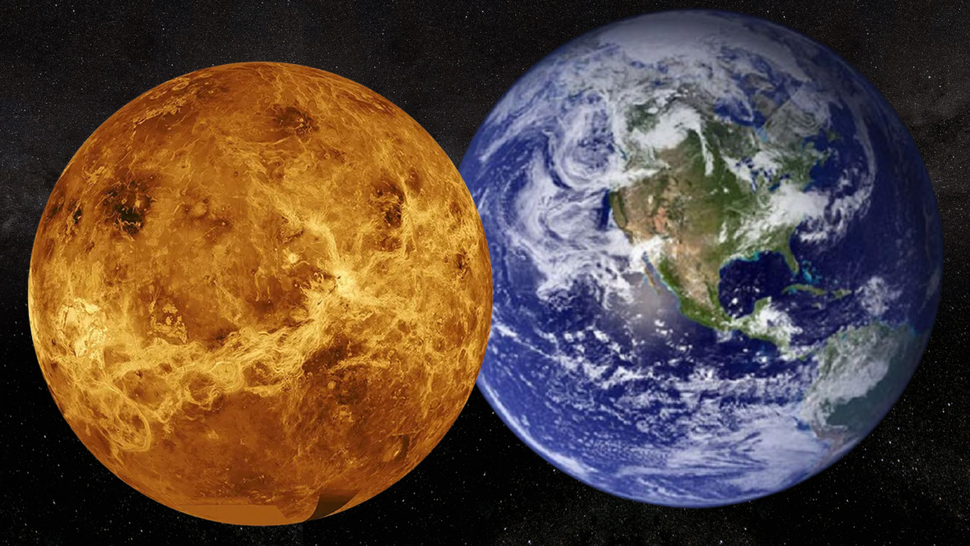“Explore the transformative journey of Venus from a potentially habitable planet to a desolate wasteland. Uncover key findings on the role of the HCO+ molecule in the drastic water loss and the future missions poised to delve deeper into Venus’s mysteries.”
Venus, often heralded as Earth’s twin due to its similar size and composition, presents a stark contrast to our vibrant, life-sustaining planet. Once teeming with the potential for life, Venus has transformed into a barren, hellish landscape, leading scientists on a quest to uncover the mechanisms behind its dramatic transformation.

Earth and Venus: A Tale of Two Planets
Both Venus and Earth share many characteristics; they are rocky planets with comparable densities and sizes, orbiting within the inner solar system. However, the similarities end there. Venus is the epitome of hostility with scorching temperatures reaching 880 degrees Fahrenheit (471 degrees Celsius) and oppressive surface pressures. Such extreme conditions make Venus hotter than Mercury, despite Mercury’s closer proximity to the Sun.
The Disappearance of Water from Venus
The mystery deepens with the knowledge that Venus, situated within the habitable “Goldilocks Zone,” likely harbored significant amounts of water billions of years ago, similar to Earth. However, a severe runaway greenhouse effect, primarily driven by excessive carbon dioxide, escalated the planet’s temperatures to current extremes. This catastrophic climate shift led to the evaporation of Venusian water, most of which was lost to space.
The Quest to Understand Venus’s Aridity
Scientists at the University of Colorado Boulder have made groundbreaking strides in understanding how Venus lost its water. Their research focuses on deciphering the “water story” on Venus, critical for understanding the conditions that support liquid water in the universe and explaining Venus’s current parched state.
Comparative Analysis of Water on Earth and Venus
To illustrate the stark differences in water content between Earth and Venus, researchers provided a compelling visualization: if Earth’s water were evenly distributed, it would form a layer approximately 2 miles deep. In contrast, the same exercise for Venus would yield a mere 1.2 inches of water, underscoring the planet’s extreme dehydration.
The Role of HCO+ in Water Loss
The pivotal discovery by the Boulder team is the identification of a molecule, HCO+ (a compound of hydrogen, carbon, and oxygen), as a significant player in the water loss from Venus’s atmosphere. This molecule, abundant in the upper atmosphere of Venus, could be instrumental in stripping the last vestiges of water by breaking down and allowing hydrogen, a crucial component of water, to escape into space.
The research utilized advanced computer models treating Venus as a massive atmospheric laboratory, enabling the scientists to simulate and analyze various chemical reactions. Their findings suggest that an excess of HCO+ molecules could have critically driven the depletion of water, rendering Venus desolate.
Challenges and Future Prospects in Venus Exploration
Despite these insights, the direct detection of HCO+ in Venus’s atmosphere remains elusive due to the lack of suitable instruments on past space missions. Venus has not been a frequent destination for spacecraft compared to Mars, limiting our understanding of its atmosphere.
Looking forward, the upcoming NASA DAVINCI mission and the European Space Agency’s EnVision mission aim to delve deeper into the mysteries of Venus. Although DAVINCI will not detect HCO+ directly, it will provide crucial data on the chemical composition of Venus’s atmosphere. These missions are expected to spark a renewed interest in Venus, potentially leading to future missions equipped to detect HCO+ and confirm its role in the planet’s transformation.
Conclusion
The evolution of Venus from a potentially habitable world to a lifeless desert continues to intrigue and challenge scientists. The latest research on the role of HCO+ in atmospheric water loss offers a new perspective on the planet’s climatic history and its stark divergence from Earth. As we prepare for future missions to Venus, we stand on the brink of potentially transformative discoveries that could not only solve the puzzles of Venus but also provide broader insights into planetary habitability and evolution across the universe.
Read More-